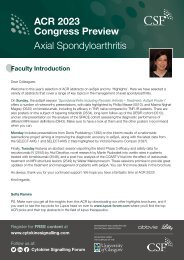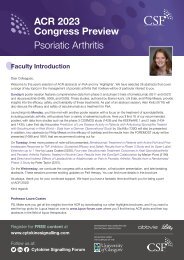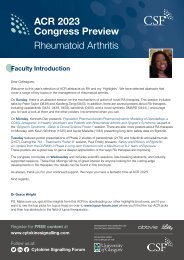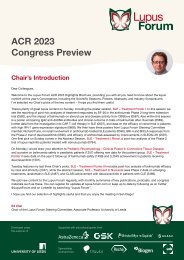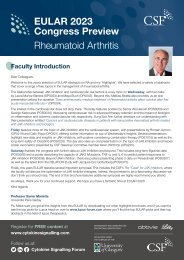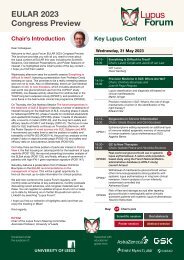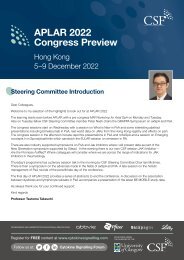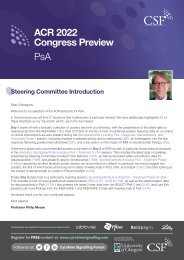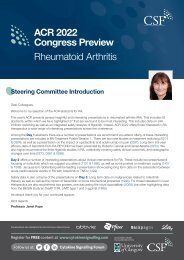EULAR 2018 Review
Create successful ePaper yourself
Turn your PDF publications into a flip-book with our unique Google optimized e-Paper software.
monocytes to differentiate into dendritic cells translated into a functional impairment of<br />
phagocytic ability. NOX5 protein expression was significantly decreased in pre-treated Mo-<br />
DC from PsA patients, and to a lesser extent in cells from RA patients. The authors<br />
proposed that inhibition of Mo-DC development by tofacitinib may alter migration of DC to<br />
the joint and subsequent activation of the immune response [#0046].<br />
Post hoc analyses of baricitinib Phase 3 studies<br />
Hepatic safety in patients with RA who received isoniazid (INH) for latent TB (LTBI) was<br />
reported by Hsieh et al. In this post hoc analysis of data from 3 Phase 3 baricitinib studies<br />
(n=2516 patients; RA-BEAM, RA BUILD, RA BEACON), 246 patients reported LTBI and<br />
169 had confirmed laboratory data and received INH as LTBI treatment. The percentage of<br />
patients with greater than one times the ULN levels of ALT was numerically higher in<br />
patients in the INH group versus no INH, and was consistent across placebo, baricitinib<br />
and adalimumab treatment groups. No treatment interruptions or discontinuations were<br />
reported in INH users in the baricitinib or adalimumab groups. The authors concluded that<br />
the data do not suggest an increased hepatic safety risk in patients receiving baricitinib<br />
and INH concomitantly [#0098].<br />
A post hoc analysis of the RA-BEAM and RA-BEGIN studies in patients with RA was<br />
reported by de Vlam, et al. The analysis showed that controlling disease activity by<br />
achieving LDA or remission increases the chance to regain normal physical function and<br />
relieve pain, independent of treatment (baricitinib monotherapy, baricitinib plus MTX or<br />
adalimumab). The data from RA-BEAM may indicate that achieving no/limited pain at<br />
Week 12 may be more likely with baricitinib compared with adalimumab, when achieving<br />
remission (83% versus 73%) [#0258].<br />
Pope and colleagues reported a post hoc analysis of RA-BEAM. The authors showed that<br />
reductions in pain and fatigue were associated with improvements in regular daily<br />
activities, presenteeism and work productivity, with patients who reported lower levels of<br />
fatigue and pain tending to experience greater improvements compared with patients with<br />
higher levels of pain and fatigue. When patients achieved a minimal level of pain (pain<br />
VAS ≤10 mm), similar improvements in presenteeism and work productivity were observed<br />
regardless of fatigue level. Similar results were observed between treatment groups<br />
[#0240].<br />
Phase 1 pharmacokinetic studies with upadacitinib in volunteers with renal impairment<br />
Mohamed, et al. reported results from a Phase 1 study that examined the<br />
pharmacokinetics of upadacitinib in 24 volunteers with either normal renal function or mild,<br />
moderate or severe renal impairment. In participants with mild, moderate and severe<br />
hepatic impairment, point estimates for plasma exposure ratios following a single 15 mg<br />
dose were 1.18, 1.33 and 1.44 for AUC and 1.06, 1.11 and 1.14 for maximum plasma<br />
concentration, relative to participants with normal renal function. The authors concluded<br />
that renal impairment has only limited effect upon upadacitinib pharmacokinetics, with<br />
mean plasma exposure in participants with severe renal impairment within 44% of that<br />
observed in patients with normal renal impairment [#0479].



